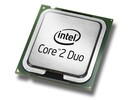Intel Core 2 Duo T9550 vs Intel Core 2 Duo T9900
Intel Core 2 Duo T9550
► remove from comparison
Die Intel Core 2 Duo T9550 Dual-Core CPU ist ein oberer Mittelklasse Dual-Core Prozessor für Notebooks. Die Architektur des Prozessors basiert auf den Penryn Kern und wird in 45nm gefertigt. Der T9550 ist vergleichbar mit dem teureren P9600, welcher jedoch auf einen TDP von 25 Watt spezifiziert ist (T9550 max. 35 Watt TDP).
Dank der 2.66 GHz und des großen Level 2 Cache von 6 MB (shared für alle beiden Kerne), ist die Anwendungsleistung für Single-Threaded Anwendungen und Spiele welche hauptsächlich einen Kern benutzen, sehr gut. Moderne Spiele, welche mehrere Threads benutzen, können jedoch von einem 4-Kerner deutlich mehr profitieren (z.B. ein Drittel mehr Leistung bei DIRT 2 beim Einsatz von 4 Kernen, siehe unseren Prozessorleistung und Spiele Artikel). In 2009 reichte die Performance des T9550 jedoch für eine flüssige Darstellung von allen Spielen (GTA4 ev. knapp) und auch anspruchsvolle Anwendungen kommen mit der Leistung gut aus.
Der Penryn (Montevina Update) Kern bietet 2 Integer Units, 1 Floating Point Unit, 1 Load Unit und 1 Store Unit in einer 14-stufigen Pipeline. Mit der Wide Dynamic Execution Technologie kann der Kern bis zu vier volle Instruktionen gleichzeitig ausführen.
Im Core 2 Duo T9550 wurden keine Features der Penryn Architektur deaktiviert. Daher unterstützt er 64 Bit, Virtualisierung und alle Stromsparfunktionen (z.B. C6 State).
Dank Dynamic Acceleration (später Turbo Modus genannt), kann sich ein Kern um eine Stufe übertakten, wenn der zweite im Idle Modus (Leerlauf) ist.
Das integrierte Enhanced Speedstep kann die Taktfrequenz des Prozessors dynamisch an die Leistungsanforderungen anpassen. Dadurch läuft die CPU ohne Last nur mit 800 MHz.
Der Core 2 Duo T9550 passt in den Socket P (BGA479, PGA478).
Intel Core 2 Duo T9900
► remove from comparison
Die Intel Core 2 Duo T9900 Dual-Core CPU löst praktisch den Core 2 Extreme X9100 (ebenfalls 3.06 GHz und 6MB L2 Cache) ab und hat zusätzlich noch einen deutlich geringeren Stromverbrauch (35 versus 44 Watt TDP dank verbessertem Stepping und Enhanced Halt State (C1E)). Einzig der freie Multiplikator unterscheidet den X9100 noch vom T9900 und bietet einen Vorteil (die einfache Übertaktbarkeit per Erhöhung des Multiplikators). Die Architektur des Prozessors basiert auf den Penryn Kern und wird in 45nm gefertigt.
Dank der hohen Taktung von 3 GHz, ist die Performance für die alle Spiele in 2009 ausreichend (nur GTA 4 profitiert deutlich von mehr Prozessorkernen). Die alten Core 2 Quad Mobilprozessoren (Q9000, QX9300) werden dank der hohen Taktung bei den meisten Spielen deutlich geschlagen. Nur Anwendungen welche mehr als 2 parallele Threads effizient nutzen können (z.B. 3D Rendering) sind auf Quad-Core Prozessoren schneller. In der Einzelthreadperformance können erst die aktuellen Core i7 Modelle den T9900 deutlich abhängen.
Der Penryn (Montevina Update) Kern bietet 2 Integer Units, 1 Floating Point Unit, 1 Load Unit und 1 Store Unit in einer 14-stufigen Pipeline. Mit der Wide Dynamic Execution Technologie kann der Kern bis zu vier volle Instruktionen gleichzeitig ausführen.
Dank Dynamic Acceleration (später Turbo Modus genannt), kann sich ein Kern um eine Stufe übertakten, wenn der zweite im Idle Modus (Leerlauf) ist.
Das integrierte Enhanced Speedstep kann die Taktfrequenz des Prozessors dynamisch an die Leistungsanforderungen anpassen. Dadurch läuft die CPU ohne Last nur mit 800 MHz.
Der Core 2 Duo T9900 passt in den Socket P (mit 479 Pins):
Socket P / Micro Flip-Chip Pin Grid Array (Micro-FCPGA) requires 479-pin surface mount Zero Insertion Force (ZIF) socket (mPGA479M socket) or Micro Flip-Chip Ball Grid Array (Micro-FCBGA) for surface mount (479-ball)
| Model | Intel Core 2 Duo T9550 | Intel Core 2 Duo T9900 |
| Codename | Penryn | Penryn |
| Series | Intel Core 2 Duo | Intel Core 2 Duo |
| Serie: Core 2 Duo Penryn | ||
| Clock | 2660 MHz | 3060 MHz |
| FSB | 1066 | 1066 |
| L1 Cache | 128 KB | 128 KB |
| L2 Cache | 6 MB | 6 MB |
| Cores / Threads | 2 / 2 | 2 / 2 |
| TDP | 35 Watt | 35 Watt |
| Transistors | 410 Million | 410 Million |
| Technology | 45 nm | 45 nm |
| Voltage | 1.05-1.212V V | 1.05-1.2125 V V |
| Die Size | 107 mm2 | 107 mm2 |
| max. Temp. | 105 °C | 105 °C |
| Socket | BGA479, PGA478 | Socket P (BGA479, PGA478) |
| Features | Virtualization, Trusted Execution, Intel 64, Enhanced Speedstep (up to C6), ExBit, SSE4.1 | SSE4.1, Virtualization Technology, Execute Disable Bit, Enhanced Speedstep, Ehnaced Halt State (C1E), 64 Bit, Trusted Execution Technology |
| Architecture | x86 | x86 |
| $316 U.S. | $530 U.S. | |
| Announced | ||
| Manufacturer | ark.intel.com | ark.intel.com |
Benchmarks
Average Benchmarks Intel Core 2 Duo T9550 → 100% n=13
Average Benchmarks Intel Core 2 Duo T9900 → 116% n=13
* Smaller numbers mean a higher performance
1 This benchmark is not used for the average calculation












